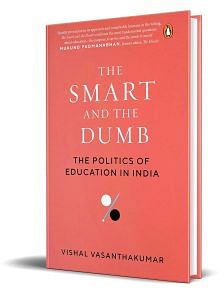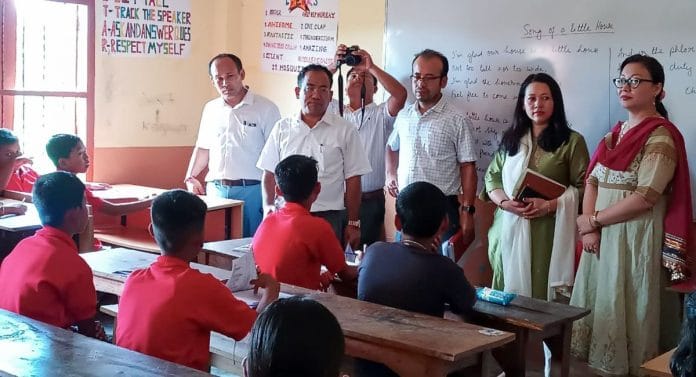The public school at Kamjong was on a flattened part of the hill. A large tract of land served as a football ground, while the school buildings lay right behind it, arranged in a rectangular pattern. Potted plants adorned the corridors, giving the entire school and classrooms a feel of serenity, a setting quite the opposite of what happened outside its campus. Perhaps, the school was a refuge, an escape from the pervasive tension, but, in its presence and functioning, it could only mask the tension and never fully hide it.
‘I came to the school soon after this incident had happened. This is the only school in the area. Kuki as well as Naga students come here to study. There were a lot of students from Chasad here,’ said one of the teachers. ‘I can still see shadows of the incident continuously lurking.’
Then, she told me what happened. Even though most students were peaceful and amicable to their classmates, there were one or two older children who incited hateful thoughts in the minds of other children. ‘After school was over, all the older Naga kids were waiting for Kuki students just outside the school. They were threatening them and calling them to a particular location for a chat. Obviously, there was not going to be a chat. The other kids knew what was going to happen.’
The school had become a site of violence in itself. ‘We had to call the student union, which is powerful here, and even the village headman to ensure the safety of our students,’ the teacher continued. ‘After school, we also had to drop children back to Chasad every day. The kids would point to the burned sites of their homes and fields and share their memories with us.’
Detailed research in trauma education has shown that in trauma-oriented groups, the individual’s identity becomes more strongly linked to his or her group identity and enemy perception. Moreover, the prevalent conception of the ‘other’ as a fixed category, that is, the enemy, dangerously increases the tendency to dehumanize the other.24 The category of ‘the other’ subsumed existing friendships among students in Kamjong, leading them to forget that ‘the other’ was a category that consisted of human beings. It was perhaps inevitable. Despite the school’s best efforts, the trauma of seeing your own house being burnt by your friend’s family members only served to increase the feeling of fear and hatred.
Soon, the effort and burden of having to walk the children back to their village proved too much for the teachers. The students had to walk through long areas of Naga territory, a proposition that made everyone uncomfortable. In a few months, all the Kuki students had stopped coming, and their education halted. The families in Chasad all decided that they would set up their own tuitions and coaching, pulling their children out of school.
‘As teachers, we couldn’t tell them to come back and promise that everything would be fine. We could guarantee their safety inside the campus, but when they left, they would still have to walk through Kamjong. They didn’t feel safe in doing so,’ said the teacher at the school.
Just as in the Phungyar school, tension was never discussed in this school, through the curriculum or even through conversations. No one particularly questioned even if it should have been brought up. Routinized classes of math and science draped a veil over the tension and trauma that the students faced outside. Perhaps because the teachers themselves never completely reconciled with their tension or trauma.
The student was taught his or her mother tongue—Thangkul to the Nagas and Thadouw to the Kukis. Identities were being reinforced in school, and sometimes new identities were created. The identity began at home, but the school was a site for its reaffirmation, for better or for worse.
‘Christmas is a very important festival in the hills,’ M said while we drank cups of very sweet tea on one of the last days of my time in Manipur. ‘Christianity came to the hill tribes through American, British and Welsh missionaries in the early 1900s, and almost everyone adopted it. But this conversion also required us to let go of particular rituals and tasks intimate to our identity. For my forefathers, it was almost a new lifestyle. Christmas is when everyone celebrates here, irrespective of any differences they have.’
‘Do you guys exchange a lot of gifts?’ I asked.
‘Yes, of course. A lot. But the only thing kids want for Christmas these days is guns,’ M sighed as the afternoon suddenly turned to night, as it usually did.
Entire generations had grown up closely involved with violence. They had had family members tortured, dismembered and killed. They had seen villages burn and had gone for days without essential supplies. The idea of education has always given people hope—to study was to imagine new possibilities and perhaps a more peaceful future. But without scope for empathy and reconciliation of trauma, education seemed to only provide the illusion of hope.
The narratives of fear, violence and anger were also sites of education, for they consumed everyone and subsumed everything. One of the purposes of a school is to build peace, but when tension and trauma aren’t integrated within the education being delivered, schools also become sites of violence. In that, the promise of education—of being a harbinger of peace, of being a promoter of economic opportunities—and an opportunity to ‘assimilate’ remains unrealized. But in such a conflict zone, the promise of education itself seemed poorly conceived and conceived in a hurry. Moreover, education was being administered under the pretext of the nation, to make children better citizens. No one asked or cared what really mattered. In these hills and this valley, seeing and feeling violence constituted education.

This excerpt from Vishal Vasanthakumar’s book ‘The Smart and the Dumb: The Politics of Education in India’ has been published with permission from Penguin Random House India.







The peaceful atmosphere of the school, with its serene surroundings and well-kept grounds, offers a brief escape from the outside tension. However, despite its calm setting, it can only temporarily shield from the reality beyond its walls.